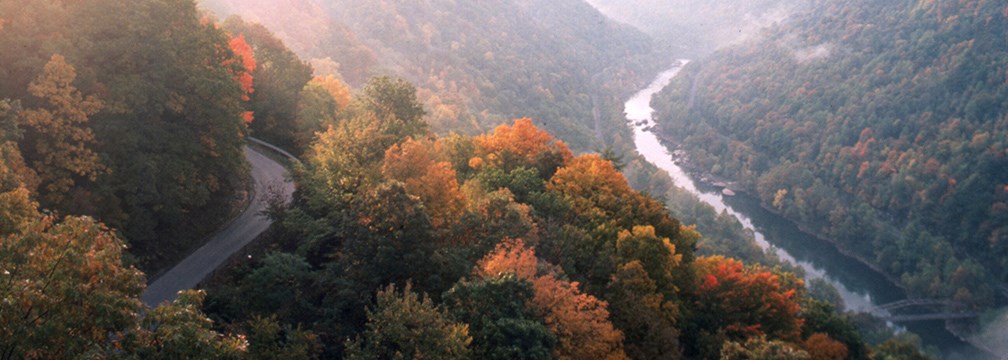
NPS 
NPS / John Chapman Exploring Fayette Station Road is to travel back in time. It takes you to a time before the construction of the modern New River Gorge Bridge in 1977. Before the New River Gorge Bridge, there was only one way to cross the gorge - a narrow, winding 8-mile-long road. This 100-year-old road winds down to the bottom of the gorge, across a narrow bridge, and up the other side. Visible along the way are vistas of the river and bridges. Hardwood forest lines the road on the side of the gorge. Remnants of the New River Gorge communities peek out from the forest. In 1873, the Chesapeake & Ohio Railway opened this rugged wilderness to the world. The railroad carried coal out of the gorge to ports in Virginia and cities in the Midwest. Between 1873 and the 1950s, West Virginia coal contributed to the Industrial Revolution. It fed the United States' trains, factories, and fleets. Coke made from West Virginia coal created steel to build factories and machines. By 1905, 13 towns sprang up between Fayette Station Road and Thurmond 15 miles upstream. There was one town about every mile! Two of these booming coal towns were Fayette and South Fayette. At river level, Fayette Station Road runs through the remnants of these towns. The creation, growth, and demise of these two towns represent the general life cycle of a town in the gorge. A landowner or mining company opened a coal mine. They built company-owned houses and a company store, creating a company town. After decades of work, the mines began to close due to depletion of the coal seam or changes in the market. As the mines closed, people moved away to find work elsewhere, deserting the towns. Today, the New River Gorge is famous for its outstanding natural and scenic beauty. Trees, flowers, and other native plants hide the remains of the once vibrant towns, mines, and homes. Along Fayette Station Road, some remnants of the coal and railroad heritage remain. Driving Fayette Station RoadFayette Station Road is an 8-mile, one-way road. It takes about 30 - 45 minutes to complete the tour. There are several pullouts along the way to admire the views of the New River Gorge and the New River Gorge Bridge. Wayside exhibits tell the story of the area. A parking lot at the bottom gives access to the New River and more views of the gorge and bridge. Remnants of the towns of Fayette and South Fayette are visible near the lower bridge. Three trails start from Fayette Station Road - the Kaymoor Trail, Fayetteville Trail, and Bridge Trail. Driving Advisory: Due to a low clearance railroad bridge, vehicles over 12 feet in height cannot complete the tour. Trailers may have difficulty crossing the railroad tracks and navigating hairpin curves. Large vehicles, RVs, and trailers are not recommended. Ask a ranger at the visitor center desk if you are unsure if your vehicle can drive Fayette Station Road. DirectionsLeaving the parking lot of Canyon Rim Visitor Center, take a left to return back to US-19. Turn right to go north on US-19. Continue for 0.3 miles and take the next right onto Lansing-Edmond Road/Truck 82. In 0.4 miles, turn right at the brown park sign for Fayette Station Road. Bear left and uphill at the fork to continue onto Fayette Station Road. The road will become a one-way road. Fayette Station Road continues down the side of the gorge to river level. It passes under the New River Gorge Bridge three times. At the bottom, cross over the reconstructed Fayette Station Bridge. This bridge reopened in 1998 as the Tunney Hunsaker Bridge. From river level, the road winds back up the side of the gorge. The road ends on US-19 near Fayetteville, only about 2 miles south of Canyon Rim Visitor Center. Fayette Station Road Audio TourAn audio tour is available for Fayette Station Road. It carries visitors back in time to when coal was king and more than forty coal mining towns lined New River Gorge. No physical copies of this tour are available. Download the audio tour from the website or use the NPS Mobile App. Since cell reception is spotty, downloading the tour to your phone is recommended. A transcript of the audio tour is also available. |
An official website of the United States government
Here's how you know
Official websites use .gov
A
.gov website belongs to an official government
organization in the United States.
Secure .gov websites use HTTPS
A
lock (
) or https:// means you've safely connected to
the .gov website. Share sensitive information only on official,
secure websites.
